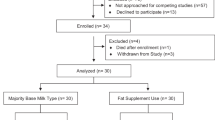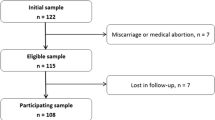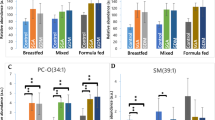Abstract
Objective: To investigate whether succeeding pregnancies will affect the maternal and neonatal docosahexaenoic acid (DHA, 22:6n-3) status. Design: Cross-sectional study. Subjects: Women who were pregnant for the 1st to 7th time and took part in a longitudinal study to investigate the essential fatty acid status of pregnant women and their infants. The total study population comprised 98 primigravidae (PG) and 146 multigravidae (MG). Main outcome measures: Fatty acid profiles of phospholipids isolated from maternal plasma samples collected during pregnancy and after delivery, and of umbilical plasma, vein and artery, obtained immediately after birth. Results: The absolute (mg/L) and relative (% of total fatty acids) amounts of DHA in maternal plasma phospholipids (PL) were significantly lower in MG than in PG. In addition, a significant negative correlation was observed between gravida number and the DHA content in maternal plasma samples. The DHA deficiency index (22:5n-6/22:4n-6) was significantly higher and the DHA sufficiency index (22:6n-3/22:5n-6) was significantly lower in umbilical plasma of infants born of MG than in that of infants born of PG. The relative DHA content of umbilical artery and vein vessel walls was significantly lower in MG- than in PG-neonates and significant negative associations were observed between birth order and the relative amounts of DHA in cord tissues. Conclusions: These results indicate that the maternal DHA status becomes reduced after each following pregnancy, which may result in a lower neonatal DHA status. Whether or not this has also functional consequences needs to be investigated further. Sponsorship: Financial support for this project was provided by Nutricia Research.
This is a preview of subscription content, access via your institution
Access options
Subscribe to this journal
Receive 12 print issues and online access
$259.00 per year
only $21.58 per issue
Buy this article
- Purchase on Springer Link
- Instant access to full article PDF
Prices may be subject to local taxes which are calculated during checkout
Similar content being viewed by others
Author information
Authors and Affiliations
Rights and permissions
About this article
Cite this article
Al, M., Houwelingen, A. & Hornstra, G. Relation between birth order and the maternal and neonatal docosahexaenoic acid status. Eur J Clin Nutr 51, 548–553 (1997). https://doi.org/10.1038/sj.ejcn.1600444
Received:
Revised:
Accepted:
Issue Date:
DOI: https://doi.org/10.1038/sj.ejcn.1600444
Keywords
This article is cited by
-
Changes in fatty acid levels (saturated, monounsaturated and polyunsaturated) during pregnancy
BMC Pregnancy and Childbirth (2021)
-
Determinants of polyunsaturated fatty acid concentrations in erythrocytes of pregnant Japanese women from a birth cohort study: study protocol and baseline findings of an adjunct study of the Japan environment & Children’s study
Environmental Health and Preventive Medicine (2017)
-
The association between interpregnancy interval and birth weight: what is the role of maternal polyunsaturated fatty acid status?
BMC Pregnancy and Childbirth (2013)
-
A maternal erythrocyte DHA content of approximately 6 g% is the DHA status at which intrauterine DHA biomagnifications turns into bioattenuation and postnatal infant DHA equilibrium is reached
European Journal of Nutrition (2012)
-
Fatty acid patterns early after premature birth, simultaneously analysed in mothers' food, breast milk and serum phospholipids of mothers and infants
Lipids in Health and Disease (2009)



